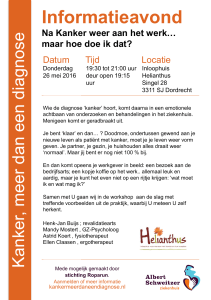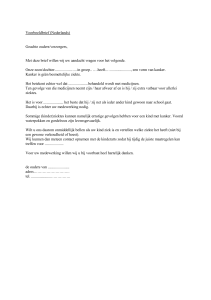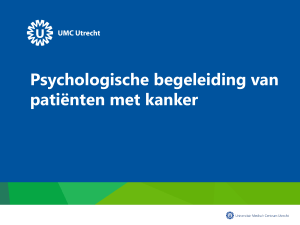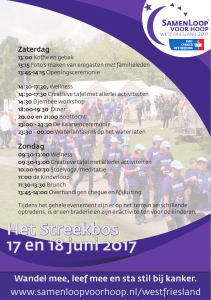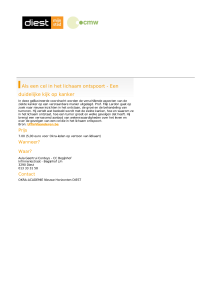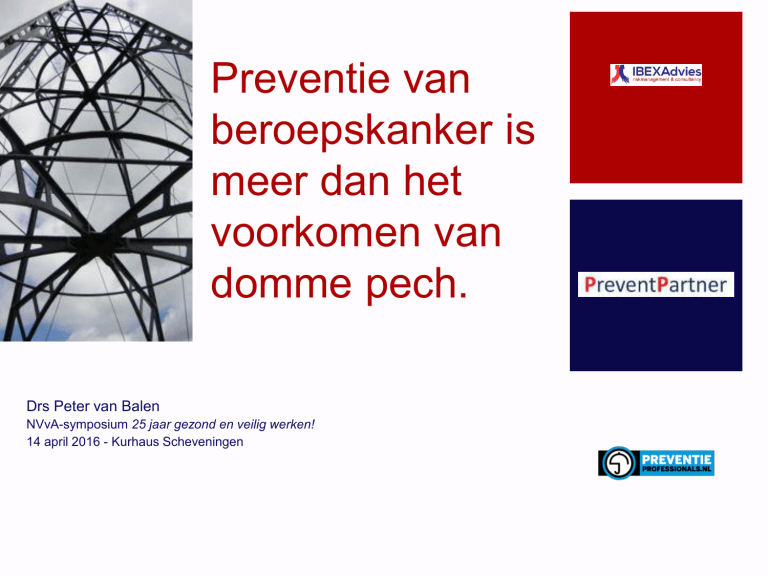
Preventie van
beroepskanker is
meer dan het
voorkomen van
domme pech.
Drs Peter van Balen
NVvA-symposium 25 jaar gezond en veilig werken!
14 april 2016 - Kurhaus Scheveningen
Outline
Overwegingen
Waar hebben we het over?
Visies op carcinogenese
Kankerverwekkende agentia
Consequenties voor preventie
Disclosure belangen spreker
(potentiële) Belangenverstregeling
Geen / Zie hieronder
•
Voor bijeenkomst mogelijk relevante relaties met
bedrijven
•
Geen
•
•
•
•
Sponsoring of onderzoeksgeld
Honorarium of andere (financiële) vergoeding
Aandeelhouder
Andere relaties
•
•
•
•
Geen
Geen
Geen
Geen
Preventie van beroepskanker
Mensen hebben twee wensen
Om gezond oud te worden moet je
jong beginnen
Oud worden en jong blijven
Kanker door het werk
28 april 2015: (ETUC)
International Workers’ Memorial
Day.
Vertraging in vaststellen
Europese grenswaarden voor
kankerverwekkende stoffen
vanaf eind 2013 zorgt voor
150.000 doden.
NL jaarlijks diagnose kanker bij
4900 personen veroorzaakt
door het werk
(4200 mannen en 700
vrouwen).
Bron: Beroepsziekten in cijfers 2014, NCvB. IKNL
2012.
Variation in cancer risk among tissues can
be explained by the number of stem cell
divisions.
Christian Tomasetti & Bert Vogelstein. Science 2 january 2015, vol 347-6217
…The majority [of the variation in cancer risk - PvB] is
due to “bad luck,” that is, random mutations arising
during DNA replication in normal, noncancreous stem
cells. ....
Waarom?
Klassiek model chemische
carcinogenese
GR 2010. Leidraad classificatie
carcinogene stoffen.
De stof is kankerverwekkend
voor de mens.
De stof moet beschouwd
worden als kankerverwekkend
voor de mens.
De stof heeft een stochastisch
genotoxisch
werkingsmechanisme, of
De stof heeft een niet-stochastisch
genotoxisch
werkingsmechanisme, of
De stof heeft een niet-genotoxisch
werkingsmechanisme, of
De genotoxiciteit is onvoldoende
onderzocht. Het is niet bekend wat
het werkingsmechanisme is.
Kankerincidentie in Nederland
Bron: Nederlandse Kankerregistratie, beheerd door IKNL © april 2016
incidentie
sterfte
Lineair (incidentie)
Lineair (sterfte)
120000
100000
Aantal
80000
60000
40000
20000
0
1990
1995
2000
2005
Jaartal
2010
2015
Demografische ontwikkelingen
bevolking en kankerdiagnoses
bronnen: CBS en Nederlandse Kankerregistratie, beheerd door IKNL © april 2016
Totale bevolking
16000
700
Mannen
Vrouwen
600
Aantal diagnoses / 100.000 mensen
18000
14000
Aantal inwoners (x 1000)
1990 - 2015
12000
10000
8000
6000
4000
500
400
300
200
100
2000
0
0
1990
Jaartal
1995
2000
2005
Jaartal
2010
2015
Nederland vergrijst
bron: CBS
18000
16000
0 - 20 jaar
20 - 45 jaar
45 - 65 jaar
65 - 80 jaar
50%
45%
80+ jaar
40%
% 45+ op totale bevolking
14000
Aantal (x1000)
12000
10000
8000
6000
4000
35%
30%
25%
20%
15%
10%
2000
5%
0
0%
Jaartal
Jaartal
0-4
5-9
10-14
15-19
20-24
25-29
30-34
35-39
40-44
45-49
50-54
55-59
60-64
65-69
70-74
75-79
80-84
85-89
90-94
95-99
Incidentie/100.000 mensen
Kankerincidentie / leeftijdscategorie
3000
2500
2000
1500
1000
500
0
Leeftijdscategorie
0-4
5-9
10-14
15-19
20-24
25-29
30-34
35-39
40-44
45-49
50-54
55-59
60-64
65-69
70-74
75-79
80-84
85-89
90-94
95-99
Incidentie/100.000 mensen
Kankerincidentie / leeftijdscategorie
3000
2500
2000
1500
1000
500
0
Leeftijdscategorie
Toeval of omgevingsfactoren?
Toevallige mutaties
Omgevingsfactoren
Substantial contribution of
Stamcel
extrinsicExtrinsieke
risk factors for cancer
factoren
development.
deling
Variation in cancer risk among
tissuesIntrinsieke
can be explained by the
numberprocessen
of stem cell divisions.
Christian Tomasetti & Bert Vogelstein. Science 2
january 2015, vol 347-6217
Song Wu, Scott Powers, Wei Zhu & Yusuf A. Hannun.
Nature 7 january 2016, vol 529.
Levenslang risico voor kanker is sterk
gecorreleerd (0.81) met het aantal delingen
van normale stamcellen.
Verklaard waarom sommige typen kanker
veel vaker voorkomen dan andere.
Slechts een derde van het variatie in
kankerrisico kan worden toegeschreven aan
omgevingsfactoren of erfelijke
predisposities.
Kanker is “domme pech”; toevallige
mutaties in genoom van normale stamcellen.
Kanker risico wordt voor het belangrijkste
deel bepaald door extrinsieke factoren:
Correlatie tussen stamceldelingen en
kankerrisico maakt geen onderscheid
tussen intrinsieke en extrinsieke factoren.
Ondergrens risicobeheersing geeft een
betere schatting voor het bepalen van
intrinsieke risico’s.
Mate van accumulatie van endogene
mutaties is te laag om kankerrisico te
verklaren.
Slechts 10-30% van het kankerrisico wordt
bepaald door intrinsieke factoren.
Kanker
risico
Preventie tot 90%?
Christopher Wild (IARC).
Precision in the Fight against the
global cancer problem.
Tot wel 90% van de kankerincidenties worden door
werkplek, milieu en andere
“extrinsieke” factoren
veroorzaakt.
Cellulair of weefsel
Somatische mutatie theorie
Douglas Hanahan & Robert A. Weinberg. The Hallmarks of
Cancer: The next generation. Cell 144, march 4, 2011
Hallmarks of cancer
1.
2.
3.
4.
5.
6.
7.
Zelfstimulatie in groeisignalen
Ongevoelig voor groeiremmers
Omzeilen van apoptosis
Oneindige potentie tot replicatie
Induceren van angiogenese
Weefsel infiltratie en metastase
Emerging Hallmarks:
a.
Dereguleren cellulaire
energiesystemen
b.
Omzeilen van immunologische
vernietiging
Enabling characteristics
a.
Genoominstabiliteit en mutatie
b.
Tumor stimulerende ontstekingen
8.
Weefsel organisatie veld theorie
Carlos Sonnenschein & Ana M. Soto. The aging of the
2000 and 2011 Hallmarks of Cancer reviews: A critique.
J. Biosci. 38(3) September 2013.
Kanker is een op weefsel
gebaseerde aandoening
Proliferatie en beweeglijkheid
zijn voorkeur stadia van alle
cellen.
a.
Aangrijpingspunt van het
carcinogene agens is de
reciproke interactie tussen
epitheel en stroma.
Halifax-project
Bron: Assessing the carcinogenic potential of low-dose exposures to chemical mixures in the environment: the challenge ahead.
Carcinogenisis, 2015, vol 36, supplement 1.
Werk gebaseerd op de SMT.
Groepen wetenschappers over hele wereld
Vragen aandacht voor cumulatieve lage-dosis
effecten van individuele niet-kankerverwekkende
stoffen die bij chronische blootstelling zorgen voor
een synergistisch effect .
Voor iedere Hallmark (kenmerk ) zijn stoffen in
milieu en arbeidsplaats aangetroffen die deze
stimuleren of in stand houden.
Bijv:
Bloedvaten aanmaken: bifenyl.
Verstoord metabolisme: cadmium.
Weefsel binnendringing en metastase: ftalaten.
Weerstand tegen celdood: lindaan.
Replicatieve onsterfelijkheid: paracetamol.
Voortdurende proliferatie signaal: ftalaten.
Tumor stimulerende ontsteking: tributyltinverbindingen.
Verstoren immuunsysteem: bisfenol A.
Omzeilen antigroeisignaal: chloorpyrifos.
Tumor microklimaat: nikkel.
Genoominstabiliteit: genotoxische carcinogenen.
Revisie van de aanpak gewenst
Gezondheidsraad.
De stof is kankerverwekkend voor
de mens.
De stof moet beschouwd worden
als kankerverwekkend voor de
mens.
De stof bevordert de
ontwikkeling van kanker bij de
mens.
De stof heeft een stochastisch
genotoxisch werkingsmechanisme,
of
De stof heeft een niet-stochastisch
genotoxisch werkingsmechanisme,
of
De stof heeft een niet-genotoxisch
werkingsmechanisme, of
De genotoxiciteit is onvoldoende
onderzocht. Het is niet bekend wat
het werkingsmechanisme is.
Uitdaging: Primaire preventie van kanker
Prognose incidentie in Nederland
120000
Effect van preventie
incidentie
sterfte
120000
primaire preventie
100000
werkelijkheid
-30%
-70%
-90%
Lineair (incidentie)
Lineair (sterfte)
100000
Lineair (primaire preventie)
80000
60000
Aantal
Aantal
80000
60000
40000
40000
20000
20000
0
1990
1995
2000
2005
Jaartal
2010
2015
0
1990
1995
2000
2005
2010
2015
Nederland reageert
Defensie:
Chroom VI problematiek ->
NS.
PX-10: [benzeen].
Brandweer:
Blaas- (en andere vormen
van) kanker als
beroepsziekte.
19 april organiseert de FNV het symposium
Langdurig nachtwerk:
‘Kankerverwekkende stoffen op het werk’
Verhoging kans op
borstkanker.
23 mei 2016 - 25 mei 2016
Aanpak werkgerelateerde kanker
Ministerie van SZW
Conferentie gericht op terugdringing van
werkgerelateerde kanker en op het stellen van meer
grenswaarden aan het werken met
kankerverwekkende stoffen.
CRM stoffen
EUROPA
Januari 2015 ECHA
5675 CRM stoffen in Europa
aanwezig
1169 geregistreerd
Nederland
SZW-lijst
855 CRM stoffen
Grenswaarden
Privaat
Publiek (min SZW)
In principe de verplichting vanuit REACH voor producenten en
leveranciers om deze vast te stellen voor alle
blootstellingsscenario’s.
Aanvullend op privaat.
Wettelijk verplicht (EU-grenswaarden en NL).
Bijlage XIIIA Arbeidsomstandighedenregeling (niet
kankerverwekkende stoffen).
en XIIIB Arbeidsomstandighedenregeling (kankerverwekkende
stoffen).
Beide gezondheidskundige grenswaarden
Uitzondering de grenswaarden voor kankerverwekkende en
mutagene stoffen en inhaleerbare allergene stoffen zonder veilige
grenswaarde -> haalbaarheidstoets.
100%
100%
90%
90%
80%
80%
70%
70%
50%
40%
30%
20%
Response
60%
drempelwaarde
Response
Grenswaarden bij kankerverwekkende
stoffen
50%
40%
30%
20%
10%
0%
60%
10%
Dosis
0%
Dosis
IARC Monographs of Carcinogenic Risks to Humans and Handbooks of Cancer Prevention
(updated November 2015)
Eye Human immunodeficiency virus type 1
Ultraviolet-emitting tanning devices
Welding
Brain and central
nervous system
X-radiation,
gamma-radiation
Alcoholic beverages
Pharynx
Alcoholic beverages
(oro-, hypo- Betel quid with tobacco
Betel quid with tobacco
and/or NOS) Human papillomavirus type 16
Betel quid without tobacco
Quitting smoking
Human papillomavirus type 16
Tobacco smoking
Quitting smoking
Smokeless tobacco
Nasopharynx Epstein-Barr virus
Tobacco smoking
Formaldehyde
Salted fish, Chinese-style
Human papillomavirus type 16
Wood dust
Salivary gland
X-radiation, gamma-radiation
Oral cavity
Tonsil
Thyroid
Radioiodines, including iodine-131
(exposure during childhood and adolescence)
X-radiation, gamma-radiation
Stomach
Upper aerodigestive tract
Helicobacter pylori
Quitting smoking
Rubber production industry
Tobacco smoking
X-radiation, gamma-radiation
Acetaldehyde associated with consumption of
alcoholic beverages
Oesophagus
Aflatoxins
Liver
(hepatocellular Alcoholic beverages
Estrogen-progestogen contraceptives
carcinoma)
Hepatitis B virus
Hepatitis C virus
Plutonium
Thorium-232 and its decay products
Tobacco smoking (in smokers and in
smokers’ children)
Liver (angiosarcoma) Vinyl chloride
Biliary tract
Pancreas
Quitting smoking
Smokeless tobacco
Tobacco smoking
Endometrium
Uterine cervix
Gall bladder Thorium-232 and its decay
products
1,2-Dichloropropane
Chlonorchis sinensis
Opisthorchis viverrini
Anus
Breast
Acetaldehyde associated with consumption of
alcoholic beverages
Alcoholic beverages
Avoidance of weight gain (adenocarcinoma)
Betel quid with tobacco
Betel quid without tobacco
Quitting smoking (squamous cell carcinoma)
Smokeless tobacco
Tobacco smoking
X-radiation, gamma-radiation
Colon and
rectum
Alcoholic beverages
Avoidance of weight gain
Regular physical activity
Tobacco smoking
X-radiation, gamma-radiation
Processed meat (consumption
of)
Human immunodeficiency virus type 1
Human papillomavirus type 16
Aluminium production
Arsenic and inorganic arsenic compounds
Asbestos (all forms)
Beryllium and beryllium compounds
Bis(chloromethyl)ether; chloromethyl methyl ether
(technical grade)
Cadmium and cadmium compounds
Nasal cavity Isopropyl alcohol manufacture using Chromium (VI) compounds
Coal, indoor emissions from household combustion
strong acids
and
Coal gasification
Leather dust
paranasal
Coal-tar pitch
Nickel compounds
sinus
Radium-226 and its decay products Coke production
Radium-228 and its decay products Diesel engine exhausts
Gamma-radiation
Tobacco smoking
Haematite mining (underground)
Wood dust
Iron and steel founding
Acid mists, strong inorganic
Larynx
MOPP (vincristine-prednisone-nitrogen mustard-procarbazine
Alcoholic beverages
mixture)
Asbestos (all forms)
Nickel compounds
Quitting smoking
Outdoor air pollution
Tobacco smoking
Outdoor air pollution, particulate matter in
Painter (occupational exposure as)
Plutonium
Pleura or peritoneum
Asbestos (all
Quitting smoking
forms)
(mesothelioma)
Radon-222 and its decay products
Erionite
Rubber production industry
Painter
Silica dust, crystalline
Alcoholic beverages
(occupational
Soot
Avoidance of weight gain
exposure as)
Sulfur mustard
(postmenopausal)
Tobacco smoke, secondhand
Diethylstilbestrol
Tobacco smoking
Estrogen-progestogen
X-radiation
contraceptives
Estrogen-progestogen
menopausal therapy
Urinary bladder Aluminium production
Mammography screening
4-Aminobiphenyl
(50˗74 years)
Arsenic and inorganic arsenic compounds
Regular physical activity
Auramine production
X-radiation, gamma-radiation
Benzidine
Kidney
Avoidance of weight gain
Chlornaphazine
Quitting smoking
Cyclophosphamide
Tobacco smoking
Magenta production
Trichloroethylene
2-Naphthylamine
X-radiation, gamma-radiation
Painter (occupational exposure as)
Quitting smoking
Renal pelvis
Aristolochic acid,
Rubber production industry
plants containing
and ureter
Schistosoma haematobium
Phenacetin
Tobacco smoking
Phenacetin, analgesic
ortho-Toluidine
mixtures containing
X-radiation, gamma-radiation
Tobacco smoking
Bone
Avoidance of weight gain
Estrogen menopausal therapy
Estrogen-progestogen menopausal therapy
Tamoxifen
Multiple sites Cyclosporine
Conventional cytology screening (35-64 years) Vagina Diethylstilbestrol (exposure in utero)
(unspecified) Fission products, including
Diethylstilbestrol (exposure in utero)
Human papillomavirus type 16
Strontium-90
Estrogen-progestogen contraceptives
X-radiation, gamma-radiation
Vulva
Human papillomavirus type 16
HPV testing
(exposure in utero)
Human immunodeficiency virus type 1
Asbestos (all forms)
Ovary
All cancers
2,3,7,8-TetrachlorodibenzoHuman papillomavirus types 16, 18, 31, 33, 35, 39,
Estrogen menopausal therapy
combined
para-dioxin
45, 51, 52, 56, 58, 59
Tobacco smoking
Quitting smoking
Tobacco smoking
Group 1 agents 2,3,4,7,8-Pentachlorodibenzofuran
Penis Human papillomavirus type 16
Polychlorinated biphenyls with a WHO TEF (“dioxin-like”)
with less than
4,4’-Methylenebis(2-chloroaniline) (MOCA)
sufficient
Alpha- and beta-particle emitters
evidence in
Areca nut
humans
Aristolochic acid
Benzidine, dyes metabolized to
Benzo[a]pyrene
Ethanol in alcoholic beverages
Ethylene oxide
Etoposide
Ionizing radiation (all types)
Neutron radiation
N′-Nitrosonornicotine (NNN) and 4-(N-nitrosomethylamino)-1-(3-pyridyl)-1-butanone (NNK)
Ultraviolet radiation
Lung
Plutonium
Radium-224 and its decay products
Radium-226 and its decay products
Radium-228 and its decay products
X-radiation, gamma-radiation
Endothelium
Human immunodeficiency virus type 1
(Kaposi
Kaposi sarcoma herpes virus
sarcoma)
Skin
(melanoma)
Skin (other
malignant
neoplasms)
Solar radiation
Polychlorinated biphenyls
Ultraviolet-emitting tanning devices
Arsenic and inorganic arsenic compounds
Azathioprine
Coal-tar distillation
Coal-tar pitch
Cyclosporine
Methoxsalen plus ultraviolet A
Mineral oils, untreated or mildly treated
Shale oils
Solar radiation
Soot
X-radiation, gamma-radiation
Leukaemia/
lymphoma
Azathioprine
Benzene
Busulfan
1,3-Butadiene
Chlorambucil
Cyclophosphamide
Cyclosporine
Epstein-Barr virus
Etoposide with cisplatin and bleomycin
Fission products, including Strontium-90
Formaldehyde
Helicobacter pylori
Hepatitis C virus
Human immunodeficiency virus type 1
Human T-cell lymphotropic virus type 1
Kaposi sarcoma herpes virus
Lindane
Melphalan
MOPP (vincristine-prednisone-nitrogen
mustard-procarbazine mixture)
Phosphorus-32, as phosphate
Rubber production industry
Semustine [1-(2-Chloroethyl)-3-(4methylcyclohexyl)-1-nitrosourea, or
methyl-CCNU]
Thiotepa
Thorium-232 and its decay products
Tobacco smoking
Treosulfan
X-radiation, gamma-radiation
Conclusies
Moderne opvattingen voor het ontstaan en de progressie van
kanker worden vormen nog steeds onderwerp voor een
wetenschappelijk dispuut.
Nederland (de GR) hanteert het principe van een cellulaire basis
voor het ontstaan van kanker.
De laatste stand van de wetenschap is dat een belangrijk deel van
kanker wordt veroorzaakt door extrinsieke factoren -> dus preventie is
mogelijk.
Er lijkt meer aandacht nodig voor synergistische effecten van niet
kankerverwekkende stoffen.
Nog niet het tumor-bevorderende effect van niet-kankerverwekkende
stoffen!
Er komen meer grenswaarden voor kankerverwekkende stoffen.
Voor primaire preventie van kanker door kankerverwekkende
stoffen blijft het voorkomen van blootstelling blijft het beste
principe.

